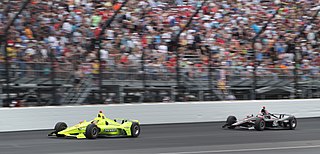Related Research Articles

The Indianapolis 500, formally known as the Indianapolis 500-Mile Race, and commonly called the Indy 500, is an annual automobile race held at Indianapolis Motor Speedway (IMS) in Speedway, Indiana, United States, an enclave suburb of Indianapolis. The event is traditionally held over Memorial Day weekend, usually the last weekend of May. It is contested as part of the IndyCar Series, the top level of American open-wheel car racing, a formula colloquially known as "Indy car racing". The track itself is nicknamed the "Brickyard", as the racing surface was paved in brick in the fall of 1909. One yard of brick remains exposed at the start/finish line. The event, billed as The Greatest Spectacle in Racing, is considered part of the Triple Crown of Motorsport along with the 24 Hours of Le Mans and the Monaco Grand Prix, with which it typically shares a date.

The Indianapolis Motor Speedway is an automobile racing circuit located in Speedway, Indiana, an enclave suburb of Indianapolis, Indiana. It is the home of the Indianapolis 500 and the Verizon 200, and formerly the home of the United States Grand Prix. It is located on the corner of 16th Street and Georgetown Road, approximately six miles (9.7 km) west of Downtown Indianapolis.

Charlotte Motor Speedway is a motorsport complex located in Concord, North Carolina, 13 mi (21 km) outside Charlotte. The complex features a 1.5 mi (2.4 km) quad oval track that hosts NASCAR racing including the prestigious Coca-Cola 600 on Memorial Day weekend, and the Bank of America Roval 400. The speedway was built in 1959 by Bruton Smith and is considered the home track for NASCAR with many race teams located in the Charlotte area. The track is owned and operated by Speedway Motorsports with Greg Walter as track president.

Atlanta Motor Speedway is a 1.54-mile entertainment facility in Hampton, Georgia, United States, 20 miles (32 km) south of Atlanta. It has annually hosted NASCAR Cup Series stock car races since its inauguration in 1960.

Midget cars, also speedcars in Australia, is a class of racing cars. The cars are very small with a very high power-to-weight ratio and typically use four cylinder engines. They originated in the United States in the 1930s and are raced on most continents. There is a worldwide tour and national midget tours in the United States, Australia, and New Zealand.

American open-wheel car racing, also known as Indy car racing, is a category of professional automobile racing in the United States. As of 2022, the top-level American open-wheel racing championship is sanctioned by IndyCar.

Langhorne Speedway was an automobile racetrack in Middletown Township, Bucks County, near the borough of Langhorne, Pennsylvania, a northern suburb of Philadelphia.
Concord Speedway was a motorsports facility located in the town of Midland, North Carolina, southeast of Concord, North Carolina. The complex featured a 1⁄2-mile asphalt tri-oval and a 1⁄4-mile asphalt oval.

The Hy-VeeDeals.com 250 presented by DoorDash and Hy-Vee Salute to Farmers 300 presented by Google are IndyCar Series races held at the Iowa Speedway in Newton, Iowa. The first event was held in 2007. From 2007 to 2013, it was a 250-lap race; beginning in 2014, the race was increased to 300 laps. For 2020, the race reverted to 250 laps, with consecutive 250-lap races on Friday and Saturday night. After being left off of the calendar for 2021, it will returned to the 2022 schedule with the 250/300 format held in years previous.
Tony Willman was an American racecar driver. He was killed in a midget car accident.

Race results from the automobile and motorcycle races contested at the Indianapolis Motor Speedway in Speedway, Indiana. Races have been held on seven different track configurations:

The Harvest Auto Racing Classic was a series of three automobile races held at the Indianapolis Motor Speedway on Saturday September 9, 1916. The meet, held four months after the 1916 Indianapolis 500, featured a 20-mile race, a 50-mile race, and a 100-mile race. The main event, a 100-mile Championship Car race, paid points towards the 1916 AAA National Championship. Johnny Aitken won all three races, two of which had a margin of victory of less than a car length.
The Las Vegas Park Speedway was a horse and automobile racing facility in Las Vegas, Nevada. It was built to be a horse racing facility and it held single races in NASCAR Grand National Series, AAA, and USAC Stock cars before it was demolished. It opened as the Las Vegas Jockey Club.
The 1909 AAA Championship Car season consisted of 24 races, beginning in Portland, Oregon on June 12 and concluding with a point-to-point race from Los Angeles, California to Phoenix, Arizona on November 6. There were three events sanctioned by the Automobile Club of America in Lowell, Massachusetts. The de facto National Champion as poled by the American automobile journal Motor Age was Bert Dingley. Points were not awarded by the AAA Contest Board during the 1909 season. Champions of the day were decided by C. G. "Chris" Sinsabaugh, an editor at Motor Age, based on merit and on track performance.
The AAA Contest Board was the motorsports arm of the American Automobile Association. The contest board sanctioned automobile races from 1904 until 1955, establishing of Championship Car racing. Modern-day IndyCar racing traces its roots directly to these AAA events.
The 1920 AAA Championship Car season consisted of 5 races, beginning in Beverly Hills, California on February 28 and concluding in Beverly Hills on November 25. The AAA National Champion and Indianapolis 500 champion was Gaston Chevrolet. The 1920 season has been a source of confusion and misinformation for historians since 1926.
The 1946 AAA Championship Car season was the first season of American Championship car racing following World War II. After four years without racing in the United States, the AAA Contest Board was initially concerned about having enough races, enough entrants, and suitable equipment, for a 1946 season. Even the Indianapolis 500 was in doubt, as the Indianapolis Motor Speedway was neglected during the war. Track owner Eddie Rickenbacker sold the track to Tony Hulman in November 1945, by which point it had fallen into a terrible state of disrepair. As the season progressed, it proved to be a success, and marked a successful return of the National Championship. Hulman's swift and herculean effort to renovate Indianapolis allowed for the 1946 Indianapolis 500 to be run as scheduled on May 30, and it was won by George Robson.

Uniontown Speedway was a wooden board track in Hopwood, near Uniontown, Pennsylvania. The track was built in 1916, after the Summit Mountain Hill Climbs were outlawed, and held its final race in June 1922. The May/June race was known as the Universal Trophy, so named because Carl Laemmle, president of Universal Films, had sponsored the $3,000, solid silver trophy. Laemmle's company filmed each race, playing them at local theaters. Two National Championship races were held at Uniontown, in 1921 and 1922.
The Grand Prix of Miami refers to an intermittent series of American open wheel races held in South Florida dating back to 1926. AAA held one board track race in 1926, and then the facility was destroyed by a hurricane. The popular CART IndyCar World Series debuted in the Miami area in the mid-1980s with a street circuit at Tamiami Park, then returned to race at Bicentennial Park in 1995.
Legion Ascot Speedway was an American race track in Los Angeles, California that operated from 1924 to 1936. It hosted AAA Champ Car races.
References
- 1 2 3 4 5 Moxley, Christopher (September 21, 2018). "Fact Friday 166 – The original Charlotte Speedway". 704 Shop. Archived from the original on 2021-05-16.
- 1 2 3 "Charlotte Speedway". ChampCarStats.com. Archived from the original on 2020-02-03.
- ↑ "Auto driver is killed on new Charlotte track". The Spartanburg Herald . October 17, 1924.
- ↑ "Charlotte board track 1926". First Super Speedway. Archived from the original on 2019-11-04.